-
ORIGINAL ARTICLE07-18-2022
Effectiveness of implementing an improvement cycle in the identification of critically ill patients
Revista Brasileira de Enfermagem. 2022;75(6):e20210346
Abstract
ORIGINAL ARTICLEEffectiveness of implementing an improvement cycle in the identification of critically ill patients
Revista Brasileira de Enfermagem. 2022;75(6):e20210346
DOI 10.1590/0034-7167-2021-0346
Views0See moreABSTRACT
Objective:
To evaluate the effectiveness of implementing a quality improvement cycle in the process for identifying critically ill patients in an intensive care center.
Methods:
The implementation of an observational and interventional improvement cycle, using a before-and-after quasi-experimental design, with a quantitative approach, in an intensive care center. Seven criteria were developed to evaluate the quality of the identification process. The results of the intervention were subjected to statistical analysis.
Results:
The quality of the identification process showed significant improvement in the values referring to compliance with the conformities in the criteria evaluated. Statistical significance was observed in the evaluations of criteria C1, C2, C3, C4, and C6, with increased compliance values after the intervention.
Final considerations:
The efficacy of the improvement cycle in the quality of the patient identification process was evidenced. It was possible to involve and encourage the participation of the care team and improve organizational processes.

-
ORIGINAL ARTICLE07-18-2022
Beliefs, knowledge, actions of nursing techniques in breastfeeding in pain management in immunization
Revista Brasileira de Enfermagem. 2022;75(6):e20210546
Abstract
ORIGINAL ARTICLEBeliefs, knowledge, actions of nursing techniques in breastfeeding in pain management in immunization
Revista Brasileira de Enfermagem. 2022;75(6):e20210546
DOI 10.1590/0034-7167-2021-0546
Views1See moreABSTRACT
Objective:
Understand the beliefs, knowledge, and actions of nursing technicians on breastfeeding as a form of non-pharmacological intervention to relieve pain in newborns and infants during immunization.
Methods:
Qualitative study carried out through semi-structured interviews with nine nursing technicians from three Basic Health Units in a city in the state of São Paulo. The theoretical approach of the Belief Model and the methodological framework of Thematic Analysis supported this study.
Results:
Three themes originated: Beliefs, Knowledge, and Actions of nursing technicians.
Final considerations:
Despite knowledge about the benefits of breastfeeding as the most effective method for relieving pain in newborns and infants during vaccination, their restrictive beliefs overrode the evidence, leading them to act in ways that discourage or prevent the mother from breastfeed during vaccination. Formal training is recommended to align with current evidence-based practices.
-
ORIGINAL ARTICLE07-18-2022
Profile of transversal skills of Nursing students to intervene in disaster situations
Revista Brasileira de Enfermagem. 2022;75(6):e20210760
Abstract
ORIGINAL ARTICLEProfile of transversal skills of Nursing students to intervene in disaster situations
Revista Brasileira de Enfermagem. 2022;75(6):e20210760
DOI 10.1590/0034-7167-2021-0760
Views0See moreABSTRACT
Objective:
to identify the profile of transversal teaching/learning skills, which allows an adequate intervention of disaster nursing students.
Methods:
this is research framed in the qualitative, transversal paradigm methodology, supported by inductive and exploratory reasoning.
Results:
it was found that there is no consensus between Nursing Education Major Coordinators/Directors and disaster nursing experts regarding transversal skills considered decisive, due to the current absence of the theme in study plans and the limited personal and professional training of professors.
Final considerations:
the development and implementation of teaching/learning strategies that allow the development of transversal skills, favoring students’ ability to meet this reality in a conscious, balanced and efficient way, is crucial.
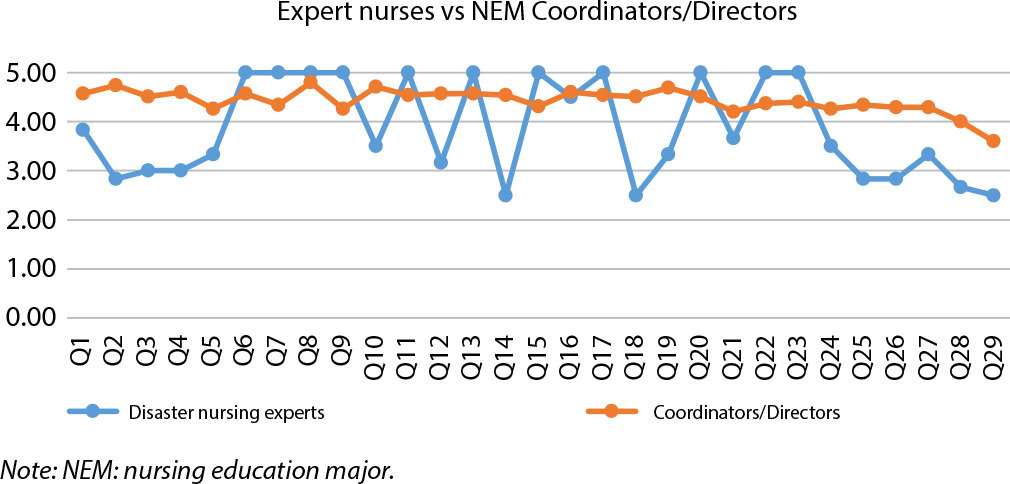
-
ORIGINAL ARTICLE07-18-2022
Legal abortion in childhood: the official discourse and the reality of a Brazilian case
Revista Brasileira de Enfermagem. 2022;75(6):e20210946
Abstract
ORIGINAL ARTICLELegal abortion in childhood: the official discourse and the reality of a Brazilian case
Revista Brasileira de Enfermagem. 2022;75(6):e20210946
DOI 10.1590/0034-7167-2021-0946
Views0See moreABSTRACT
Objective:
to identify the ideological perspectives of official discourses in relation to sexual violence, childhood pregnancy and access to legal abortion based on a Brazilian case.
Methods:
a qualitative documentary study. Data collection was carried out in documents published on official Brazilian websites, between August and December 2020. The analytical categories of gender and generation supported data analysis.
Results:
a total of 39 documents were selected and three empirical categories were identified: Protection against violence in the legislation and the (re)production of injuries in reality; Facing sexual violence against children by the Brazilian State; Being a Brazilian girl: gender and generational oppressions.
Final considerations:
the ideological perspectives of official discourses in relation to the case showed a lack of compliance with advances in Brazilian legislation on issues related to child violence and adult-centric authoritarianism, with the imposition of gender and generation subalternity.
-
ORIGINAL ARTICLE07-18-2022
Shift work schedule and damage to nursing workers’ health at Brazilian public hospital
Revista Brasileira de Enfermagem. 2022;75(6):e20210836
Abstract
ORIGINAL ARTICLEShift work schedule and damage to nursing workers’ health at Brazilian public hospital
Revista Brasileira de Enfermagem. 2022;75(6):e20210836
DOI 10.1590/0034-7167-2021-0836
Views0See moreABSTRACT
Objective:
to compare work-related damage between the day and night shifts of nursing workers in at a public hospital.
Methods:
a cross-sectional, and correlational study, conducted with 308 nursing workers from a Brazilian public hospital. Data collection took place from September 2017 to April 2018 using self-administered questionnaires that investigated socio-occupational variables and the effects of work (Work-Related Damage Assessment Scale). Analysis was descriptive and analytical with a 5% significance level.
Results:
during the day shift, the variables that most influenced nursing professionals’ health were body pain, headache, back pain, legs pain, and sleep disorders. When comparing the shifts, it was identified that daytime influences the studied variables more than nighttime. Job tenure was correlated with psychological damage.
Conclusions:
the results showed a greater influence of the day shift on the health of professionals who work in a hospital environment. Job tenure influences psychological damage.
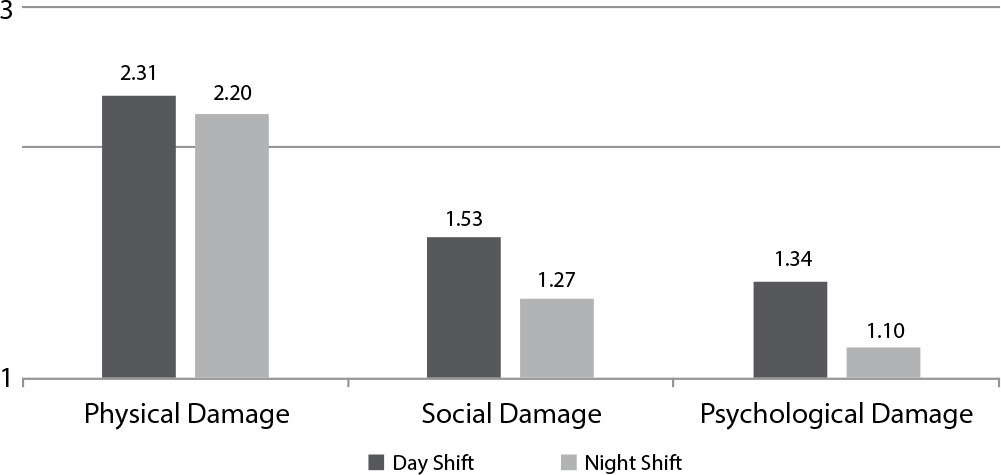
-
07-18-2022
Turno de trabalho e danos à saúde dos trabalhadores de enfermagem em um hospital público brasileiro
Revista Brasileira de Enfermagem. 2022;75(6):e20210836
Abstract
Turno de trabalho e danos à saúde dos trabalhadores de enfermagem em um hospital público brasileiro
Revista Brasileira de Enfermagem. 2022;75(6):e20210836
DOI 10.1590/0034-7167-2021-0836
Views0See moreRESUMEN
Objetivo:
comparar los daños relacionados con el trabajo entre los turnos diurno y nocturno de trabajadores de enfermería en un hospital público.
Método:
estudio transversal y correlacional, realizado con 308 trabajadores de enfermería de un hospital público brasileño. La recolección de datos ocurrió de septiembre de 2017 a abril de 2018 a través de cuestionarios autoadministrados que investigaron variables sociolaborales y efectos del trabajo (Escala de Evaluación de Lesiones Relacionadas con el Trabajo). El análisis fue descriptivo y analítico, con un nivel de significancia del 5%.
Resultados:
en el turno diurno, las variables que más influyeron en la salud de los profesionales de enfermería fueron el dolor en el cuerpo, cabeza, espalda, piernas y alteraciones en el sueño. Al comparar los turnos, se identificó que el día influye más que la noche en las variables estudiadas. El tiempo de trabajo se correlacionó con el daño psicológico.
Conclusión:
los resultados mostraron una mayor influencia del turno diurno en la salud de los profesionales de enfermería en ambiente hospitalario. El tiempo de trabajo influyó en el daño psicológico.
-
ORIGINAL ARTICLE07-18-2022
Translation, cross-cultural adaptation and content validation of the Global Trigger Tool surgical module
Revista Brasileira de Enfermagem. 2022;75(6):e20210859
Abstract
ORIGINAL ARTICLETranslation, cross-cultural adaptation and content validation of the Global Trigger Tool surgical module
Revista Brasileira de Enfermagem. 2022;75(6):e20210859
DOI 10.1590/0034-7167-2021-0859
Views0See moreABSTRACT
Objective:
to translate, cross-culturally adapt and validate the Global Trigger Tool surgical module content for Brazil.
Method:
this is methodological research, carried out between March/2018 and February/2019, following the steps of translation, synthesis, back-translation, validation by the Delphi technique, pre-test and presentation to developers. Two translators, two back-translators, six professionals participated in the expert committee. A pre-test was carried out with a retrospective analysis of 244 medical records of adult patients. The content validity index and Cronbach’s alpha were determined for data analysis.
Results:
the translation and cross-cultural adaptation allowed adjustments of items for use in Brazil. The mean Content Validity Index was 1.38, and the degree of agreement among experts was 92.4%. Cronbach’s alpha was 0.83 for the 11 surgical triggers and their guidelines.
Conclusion:
the module was translated, cross-culturally adapted for Brazil, with high reliability to identify surgical adverse events.

-
ORIGINAL ARTICLE07-18-2022
Factors associated with the use of the N95 respirator in university students in the daily life of COVID-19
Revista Brasileira de Enfermagem. 2022;75(6):e20210412
Abstract
ORIGINAL ARTICLEFactors associated with the use of the N95 respirator in university students in the daily life of COVID-19
Revista Brasileira de Enfermagem. 2022;75(6):e20210412
DOI 10.1590/0034-7167-2021-0412
Views0See moreABSTRACT
Objective:
To identify the factors associated with the use of the N95 respirator in Nursing and Medical students in the daily life of the covid-19 pandemic.
Methods:
Descriptive-analytical cross-sectional study carried out in 2020. A total of 830 students from three universities in Peru participated in the study. Associations were evaluated using Pearson’s Chi-Square and multivariate Poisson modeling with log linkage.
Results:
Statistically significant differences were found between the preference to use the N95 respirator in relation to masks according to the activity they perform (p=0.001) and where they live (p=0.005). The multivariate analysis reported that the associated characteristics were age, activity performed, perception and fear of being infected by covid-19.
Conclusion:
The choice of N95 respirator is influenced by individual factors and perceptions. Spaces are needed to discuss daily life, the way of living, caring and educating, considering the socioeconomic dimensions and beliefs.
-
06-01-2015
Health promotion in supplementary health care: outsourcing, microregulation and implications for care
Revista Brasileira de Enfermagem. 2015;68(3):482-489
Abstract
Health promotion in supplementary health care: outsourcing, microregulation and implications for care
Revista Brasileira de Enfermagem. 2015;68(3):482-489
DOI 10.1590/0034-7167.2015680315i
Views1See moreABSTRACT
Objective:
to analyze health promotion programs in the supplementary health care.
Methods:
This was a multiple case study with a qualitative approach whose data were obtained from interviews with coordinators of providers contracted by the corporations of health insurance plans in Belo Horizonte, Minas Gerais. The data were submitted to Critical Discourse Analysis.
Results:
Home care has been described as the main action in the fi eld of health promotion transferred to the providers, followed by management of patients and cases, and the health education.groups. The existence of health promotion principles is questionable in all programs. Outsourcing is marked by a process with a division between cost and care management. Implications of this process occur within admission and interventions on the needs of the benefi ciaries.
Conclusions:
Statements revealed rationalization of cost, restructuring of work, and reproduction of the dominant logic of capital accumulation by the health insurance companies.
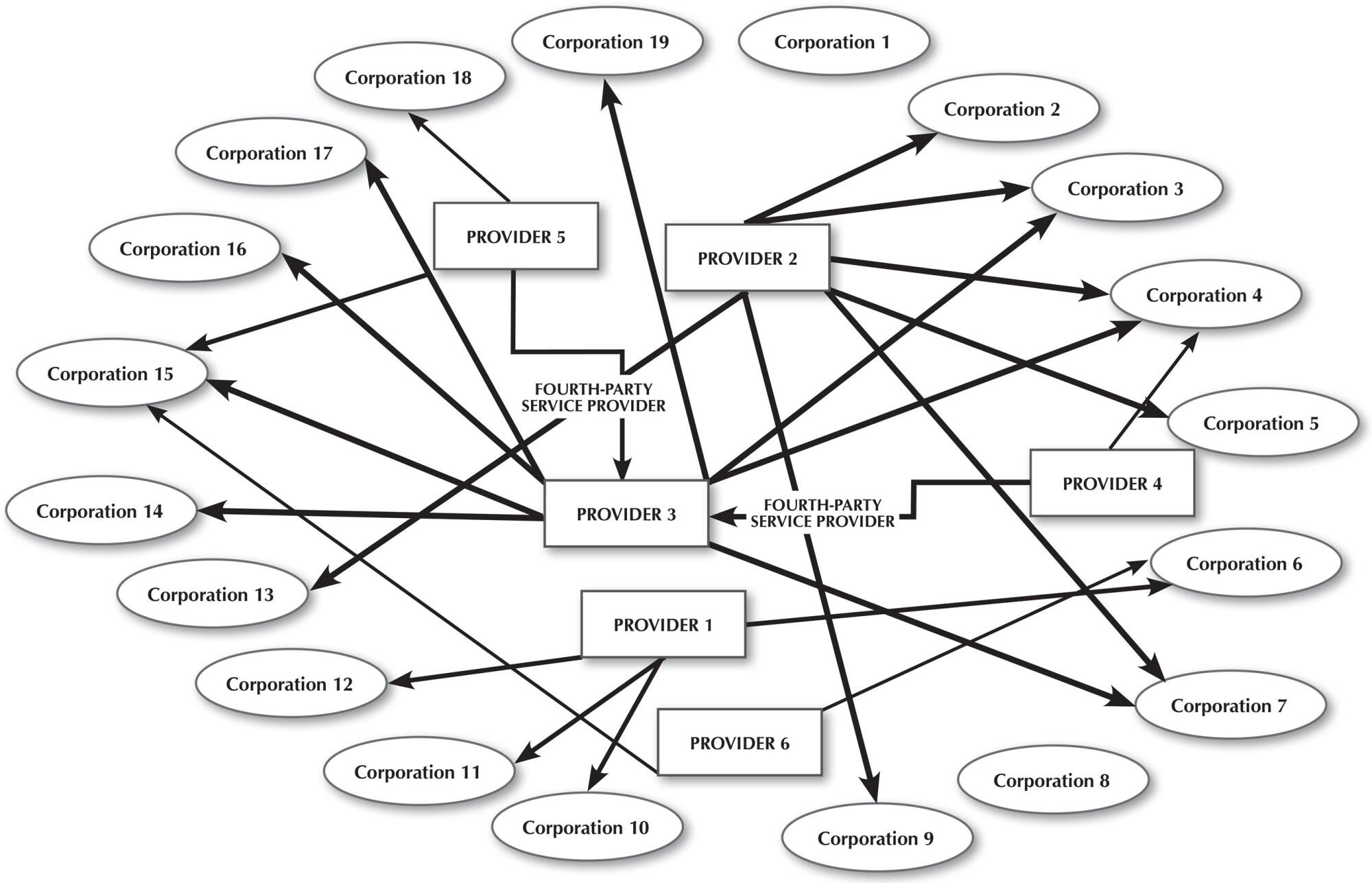
-
ORIGINAL ARTICLE01-01-2019
Knowledge and behavior of professionals about bundled strategies of central venous catheter
Revista Brasileira de Enfermagem. 2019;72(1):50-56
Abstract
ORIGINAL ARTICLEKnowledge and behavior of professionals about bundled strategies of central venous catheter
Revista Brasileira de Enfermagem. 2019;72(1):50-56
DOI 10.1590/0034-7167-2018-0164
Views1See moreABSTRACT
Objective:
To investigate the factors that influence the knowledge and behavior of professionals of neonatal and pediatric units about bundled strategies of insertion of central venous catheter.
Method:
This is a cross-sectional study, conducted in one neonatal and one pediatric intensive care units in a public hospital in Belo Horizonte, Brazil, from April to July, 2016. The sample consisted of 255 professionals who answered a structured instrument. Descriptive and comparative analyses were made using the SPSS software.
Results:
The category nursing professional (p = 0.010), working hours of 12×36 scale (p < 0.001), training as a form of acquiring knowledge (p < 0.001) and participation in training programs (p < 0.001) are associated to greater knowledge about the bundle. Regarding behavior, no significant associations were observed.
Conclusion:
The study showed that there are factors that influence the knowledge about bundled strategies of insertion of central venous catheter, reflecting the need to consider these practices for making more effective educational practices in health care.
-
ORIGINAL ARTICLE12-13-2019
Factors associated with low Apgar in newborns in birth center
Revista Brasileira de Enfermagem. 2019;72:297-304
Abstract
ORIGINAL ARTICLEFactors associated with low Apgar in newborns in birth center
Revista Brasileira de Enfermagem. 2019;72:297-304
DOI 10.1590/0034-7167-2018-0924
Views1See moreABSTRACT
Objective:
to analyze factors associated with Apgar of 5 minutes less than 7 of newborns of women selected for care at the Center for Normal Birth (ANC).
Method:
a descriptive cross-sectional study with data from 9,135 newborns collected between July 2001 and December 2012. The analysis used absolute and relative frequency frequencies and bivariate analysis using Pearson’s chi-square test or the exact Fisher.
Results:
fifty-three newborns (0.6%) had Apgar less than 7 in the 5th minute. The multivariate analysis found a positive association between low Apgar and gestational age less than 37 weeks, gestational pathologies and intercurrences in labor. The presence of the companion was a protective factor.
Conclusion:
the Normal Birth Center is a viable option for newborns of low risk women as long as the protocol for screening low-risk women is followed.
-
ORIGINAL ARTICLE04-09-2020
Factors associated with the discontinuance of outpatient follow-up in neonatal units
Revista Brasileira de Enfermagem. 2020;73(3):e20180793
Abstract
ORIGINAL ARTICLEFactors associated with the discontinuance of outpatient follow-up in neonatal units
Revista Brasileira de Enfermagem. 2020;73(3):e20180793
DOI 10.1590/0034-7167-2018-0793
Views1See moreABSTRACT
Objectives:
to identify predisposing and enabling factors as well as the health needs associated with the discontinuance of outpatient follow-up of newborns who were hospitalized at neonatal intensive care unit.
Methods:
cross-sectional study, using the behavioral model of health services use. The study was composed of 358 mothers and newborns referred to the outpatient follow-up after discharge. Characterization, perception of social support, postnatal depression, and attendance to appointments data were collected, analyzed by the R software (3.3.1).
Results:
outpatient follow-up was discontinued by 31.28% of children in the first year after discharge. In multiple regression analysis, the chance of discontinuance was higher for newborns who used mechanical ventilation (OR = 1.68; 95%CI 1.04-2.72) and depended on technology (OR = 3.54; 95%CI 1.32-9.5).
Conclusions:
predisposing factors were associated with the discontinuance of follow-up; enabling factors and health needs did not present a significant association. Children with more complex health conditions require additional support to participate in follow-up programs, thus ensuring the continuity of care.

-
ORIGINAL ARTICLE02-22-2021
Analysis of vaccine loss due to temperature change
Revista Brasileira de Enfermagem. 2021;74(1):e20190762
Abstract
ORIGINAL ARTICLEAnalysis of vaccine loss due to temperature change
Revista Brasileira de Enfermagem. 2021;74(1):e20190762
DOI 10.1590/0034-7167-2019-0762
Views1See moreABSTRACT
Objectives:
to analyze vaccine losses in a Health Region in the Northwest of São Paulo.
Methods:
retrospective cross-sectional study with secondary data obtained from Temperature Change Notification Forms used by the Epidemiological Surveillance Group XXIX of São José do Rio Preto between 2010 and 2017. Descriptive and inferential analysis were performed using multiple linear regression and significance level of 95%.
Results:
in total, 341 notifications of temperature changes were analyzed, of which 70.1% were caused by structural reasons, 57.8% in industrial refrigerators and 91.2% in primary care services. Of the doses that suffered a change in temperature, 41.4% were lost and 58.6% were administered to the population. The highest percentage of lost doses compared to those applied occurred in smaller municipalities, although they reported less.
Conclusions:
nursing workers who work in vaccination rooms should make efforts to prevent temperature changes and avoid losses and higher public expenses.
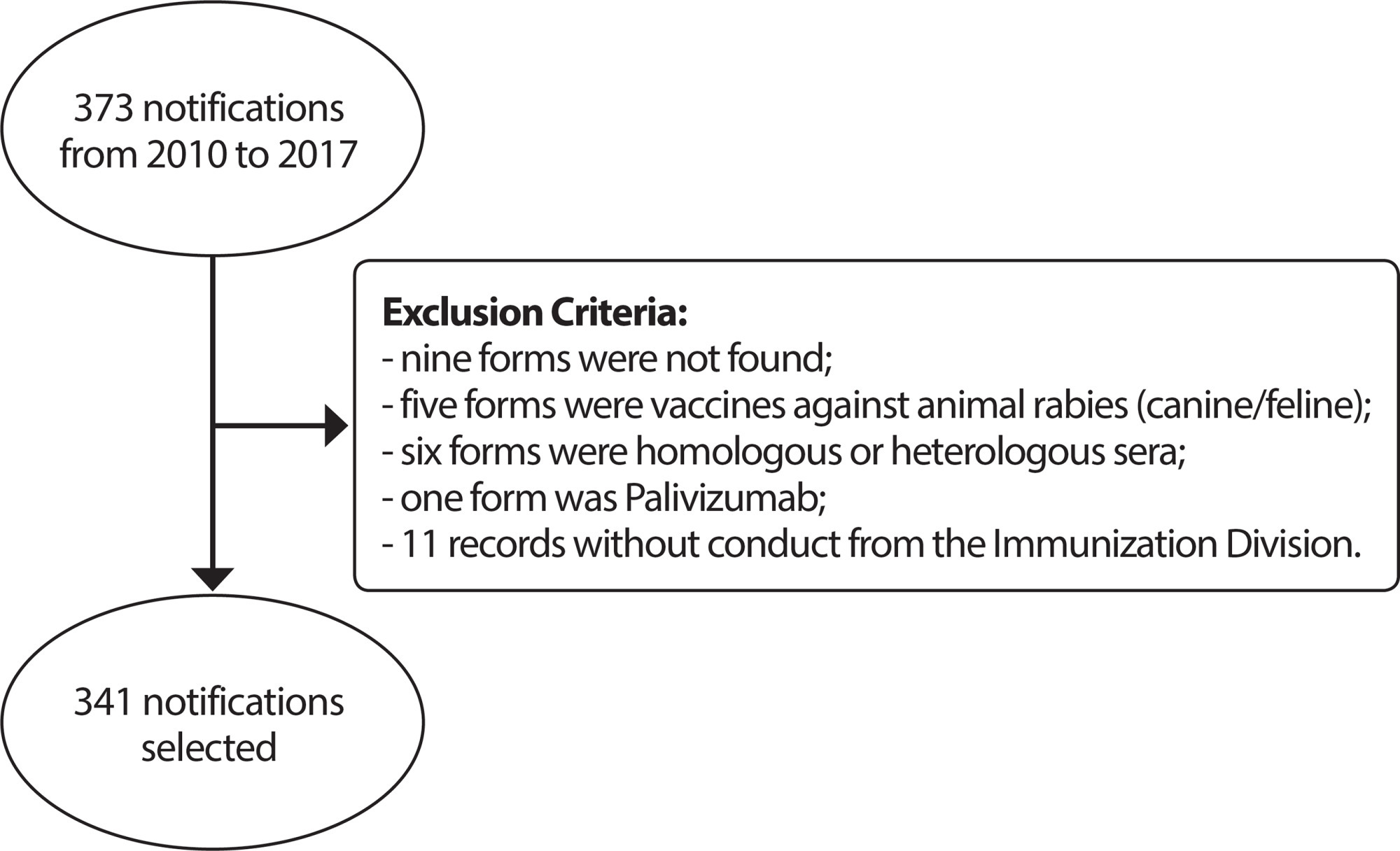
-
ORIGINAL ARTICLE09-26-2022
Participatory development of educational technology in seeking patient safety in maternity hospitals
Revista Brasileira de Enfermagem. 2022;75(5):e20210701
Abstract
ORIGINAL ARTICLEParticipatory development of educational technology in seeking patient safety in maternity hospitals
Revista Brasileira de Enfermagem. 2022;75(5):e20210701
DOI 10.1590/0034-7167-2021-0701
Views1See moreABSTRACT
Objectives:
to develop a booklet as an educational technology, together with health professionals, patients and companions, aiming at their involvement in patient safety in maternity hospitals.
Methods:
a qualitative convergent care study, carried out in three stages at a maternity hospital in Belo Horizonte. The booklet construction took place between February and April 2021, with 13 professionals, 06 companions and 11 patients.
Results:
data content analysis was performed, creating three categories: Knowledge and experiences about patient and newborn safety in maternity hospitals; Challenges for involving patient and companion in safety actions; Assessment of patients, companions and professionals on the booklet construction process. The booklet construction involved the participation of health professionals, users and companions in all stages of the process.
Final considerations:
the participatory process enabled the creation of educational technology for the involvement of patients and companions in patient safety actions.
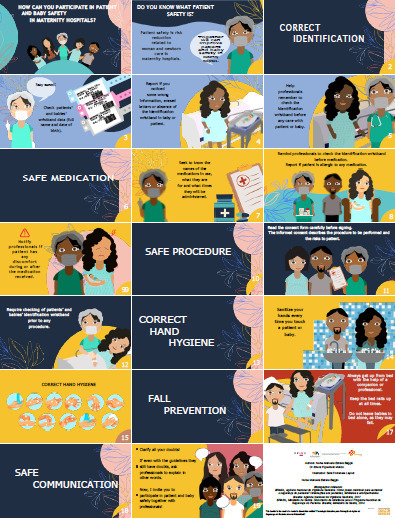
-
12-08-2023
Nursing experiences in specialized services in child and adolescent mental health: a systematic review of qualitative studies
Revista Brasileira de Enfermagem. 2023;76:e20220550
Abstract
Nursing experiences in specialized services in child and adolescent mental health: a systematic review of qualitative studies
Revista Brasileira de Enfermagem. 2023;76:e20220550
DOI 10.1590/0034-7167-2022-0550
Views1See moreABSTRACT
Objective:
to synthesize evidence from qualitative studies on nursing experiences regarding child and adolescent mental health care in specialized services.
Method:
a systematic review with meta-synthesis of qualitative studies according to JBI guidelines. CINAHL, EMBASE, MEDLINE, LILACS, PSYCinfo, Scopus and Web of Science databases were used. The findings were classified according to the level of reliability and credibility and categorized by similarity between contents.
Results:
229 articles were identified, and five were included in the final sample and organized into the categories: Emotional impact; and Understanding nursing role. The level of evidence found was moderate.
Final considerations:
nursing experiences are permeated by emotional exhaustion, feelings of frustration and difficulty in understanding their professional role. The need for training spaces that qualify this care is highlighted.
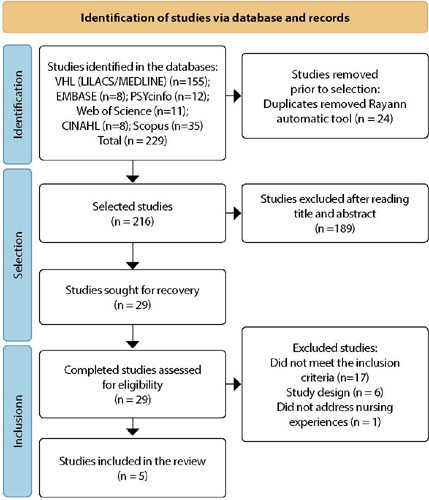
-
ORIGINAL ARTICLE07-19-2024
Validation of an instrument for assessing leprosy care in children and adolescents
Revista Brasileira de Enfermagem. 2024;77(2):e20230344
Abstract
ORIGINAL ARTICLEValidation of an instrument for assessing leprosy care in children and adolescents
Revista Brasileira de Enfermagem. 2024;77(2):e20230344
DOI 10.1590/0034-7167-2023-0344
Views1See moreABSTRACT
Objectives:
to validate the content of an instrument for assessing leprosy care in individuals under 15 years old in the context of Primary Health Care.
Methods:
methodological study of content validation, based on the evaluation of essential and derived attributes in primary care, in the professional version. For data analysis, the Content Validation Index (CVI ≥ 0.8) and Cronbach’s Alpha were calculated.
Results:
a higher percentage of judges among nurses (61.5%) was observed; with a doctorate (46.2%), and engaged in teaching and research (77%). The overall Content Validation Index of the instrument was 0.98. In the analysis of Cronbach’s Alpha of the instrument, the assigned value was 0.717.
Conclusions:
the instrument represents an advancement in the measurement of health evaluation policies and can significantly contribute to improving the quality of care provided to children and adolescents with leprosy.
-
REVIEW06-01-2020
Access of the black population to health services: integrative review
Revista Brasileira de Enfermagem. 2020;73(4):e20180834
Abstract
REVIEWAccess of the black population to health services: integrative review
Revista Brasileira de Enfermagem. 2020;73(4):e20180834
DOI 10.1590/0034-7167-2018-0834
Views1See moreABSTRACT
Objectives:
demonstrate and discuss how the black population’s access to health services occurs
Methods:
integrative literature review with the following question: How does the black population’s access to health services occur? The search was carried out in the Scholar, LILACS and SciELO databases and used the descriptor “access to health services” and the term “population,” resulting in a sample with twelve articles.
Results:
studies show that the difficulty of access is a fundamental factor for the quality of life of people, directly compromising preventive services, especially for women’s health and, in addition, it has significant impact on the illness process of the black population within its particularities.
Final Considerations:
several limiting factors compromise the black population’s access to health services, including institutional and structural factors

-
REVIEW11-06-2020
Transitional care to caregivers of dependent older people: an integrative literature review
Revista Brasileira de Enfermagem. 2020;73:e20200394
Abstract
REVIEWTransitional care to caregivers of dependent older people: an integrative literature review
Revista Brasileira de Enfermagem. 2020;73:e20200394
DOI 10.1590/0034-7167-2020-0394
Views1See moreABSTRACT
Objective:
To identify the needs of caregivers of dependent older people related to self-care in the transition from hospital to home.
Methods:
Integrative literature review that followed a predefined protocol, carried out from March to May 2019 in the platforms EBSCO, B-On, Scopus, Web of Science, and Joanna Briggs Institute. Descriptors and eligibility criteria were defined for the bibliographic sample, which was ten articles. The search was limited to articles published between 2015 and 2019 to guarantee evidence topicality.
Results:
The needs of caregivers related to transitional care can be grouped into five categories: needs in the transition into the role of caregiver; needs related to self-care of caregivers themselves; health needs; economic needs; and social and collective needs.
Final considerations:
The work developed by nurses regarding transitional care of caregivers must have two focuses: managing care provided to dependent older people and managing the needs of caregivers and the care offered to them.
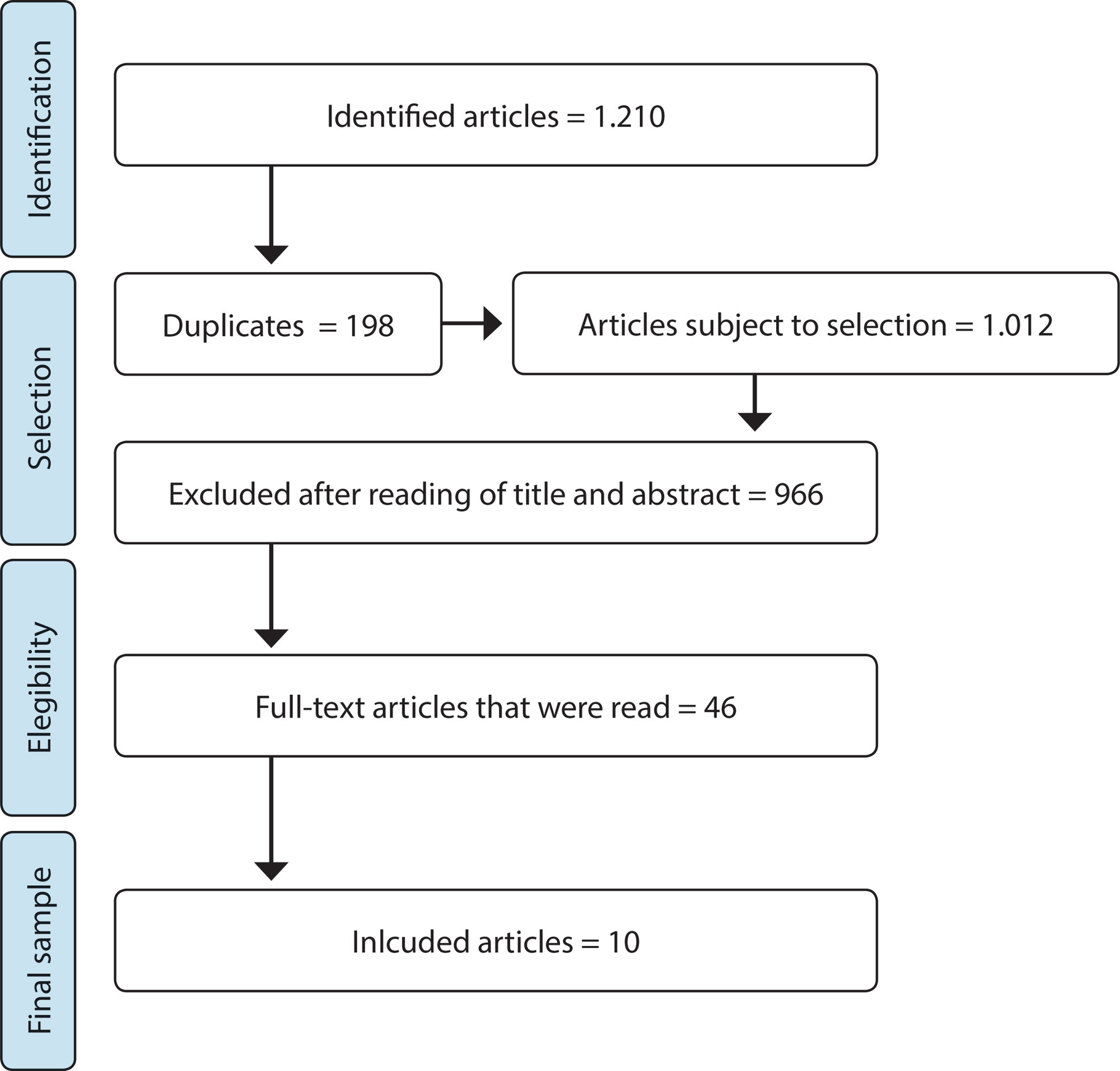
-
REVIEW10-19-2020
Validation methods of nursing protocols: an integrative review
Revista Brasileira de Enfermagem. 2020;73:e20200050
Abstract
REVIEWValidation methods of nursing protocols: an integrative review
Revista Brasileira de Enfermagem. 2020;73:e20200050
DOI 10.1590/0034-7167-2020-0050
Views0See moreABSTRACT
Objective:
to identify scientific production about validation methods of nursing care protocols.
Method:
an integrative review with search at Scielo, Pubmed/MEDLINE, Virtual Health Library, Web of Science, Scopus, and EBSCOhost. The descriptors “validation studies”, “validation studies as topic”, “protocols”, “clinical protocols”, “practice guidelines as topic”, “nursing” and “nursing assessment” and the uncontrolled descriptor “validation” were used.
Results:
thirty-two articles were selected, most of them Brazilian. Content validation by experts was the most frequent method, with no consensus on the number of participants for the process. The collection instruments were mostly created by the authors. Data analysis was performed using descriptive statistics and Content Validity Index, with a variable consensus rate in the analyzed articles.
Conclusion:
protocols validated by experts are robust tools for use in clinical practice, with methodological rigor in development essential for its quality.
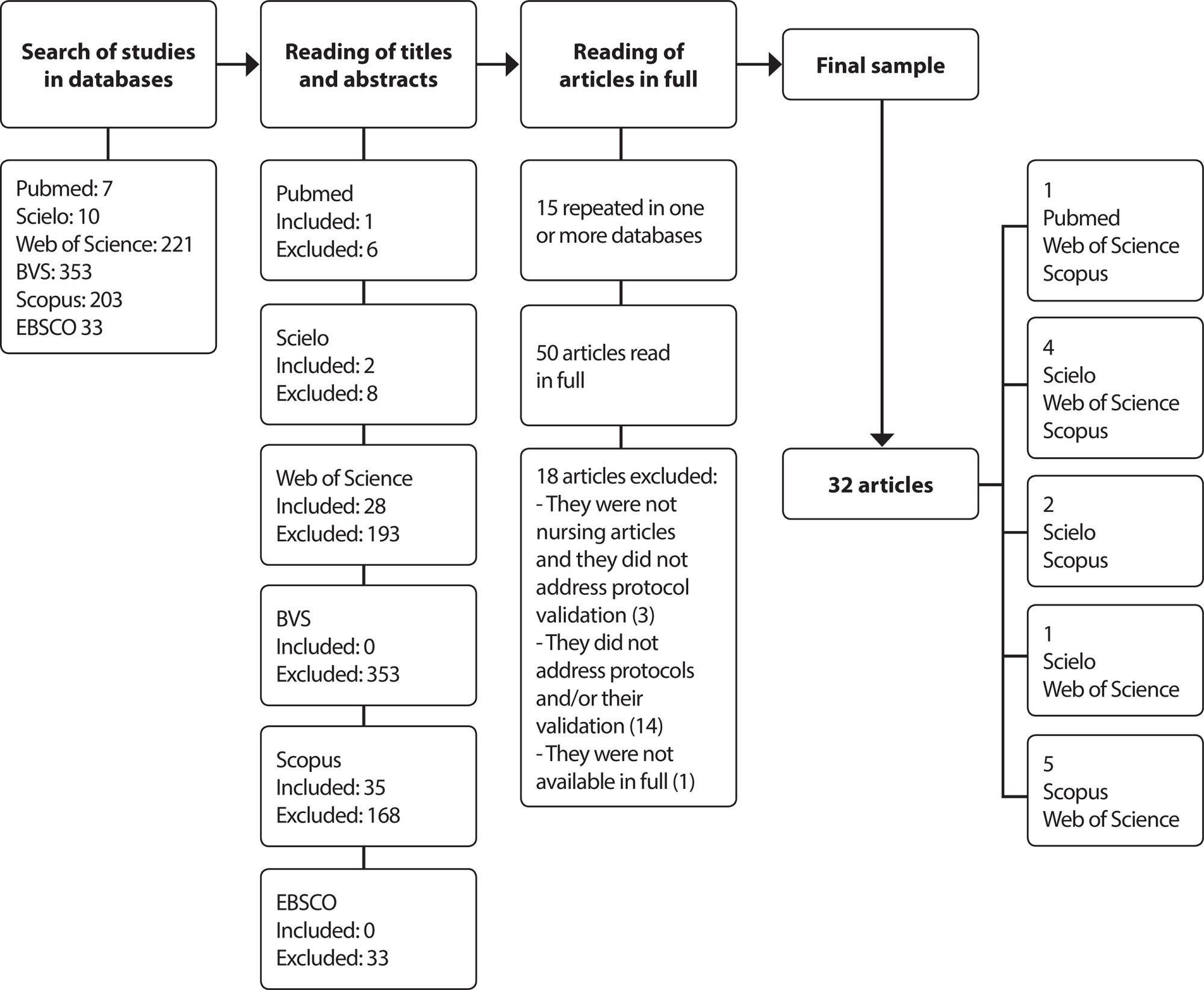
-
ORIGINAL ARTICLE05-24-2021
PEDCARE: validation of a mobile application on diabetic foot self-care
Revista Brasileira de Enfermagem. 2021;74:e20200856
Abstract
ORIGINAL ARTICLEPEDCARE: validation of a mobile application on diabetic foot self-care
Revista Brasileira de Enfermagem. 2021;74:e20200856
DOI 10.1590/0034-7167-2020-0856
Views0See moreABSTRACT
Objective:
to describe the process of validating a multimedia application on a mobile platform to promote foot care for people with diabetes.
Method:
a technological production and methodological type study. Content and appearance were validated by 39 judges (29 nursing judges and ten information and communication technology judges and 15 people from the target audience).
Results:
nursing judges made it possible to validate the material with a total Content Validity Index of 0.95, a non-significant binomial test for most items and Cronbach’s alpha of 0.92, information and communication technology judges with Suitability Assessment of Materials of 99.2% and the target audience with an agreement index of 98%.
Conclusion:
the application proved to be valid and reliable for use in clinical practice as an educational technology to promote foot care for people with diabetes.
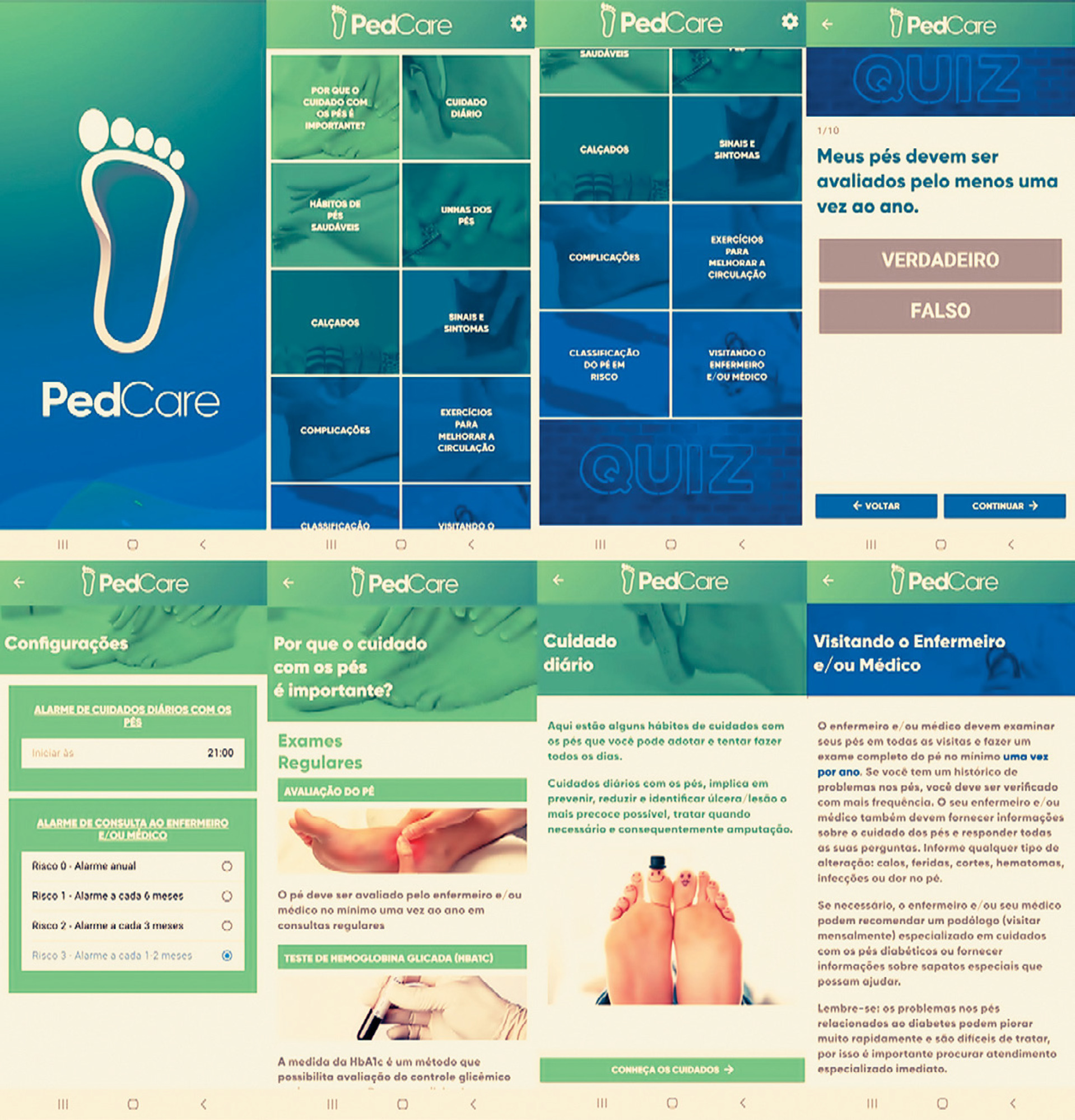
-
EXPERIENCE REPORT04-09-2020
Implementation of an Artificial Intelligence Algorithm for sepsis detection
Revista Brasileira de Enfermagem. 2020;73(3):e20180421
Abstract
EXPERIENCE REPORTImplementation of an Artificial Intelligence Algorithm for sepsis detection
Revista Brasileira de Enfermagem. 2020;73(3):e20180421
DOI 10.1590/0034-7167-2018-0421
Views0See moreABSTRACT
Objectives:
to present the nurses’ experience with technological tools to support the early identification of sepsis.
Methods:
experience report before and after the implementation of artificial intelligence algorithms in the clinical practice of a philanthropic hospital, in the first half of 2018.
Results:
describe the motivation for the creation and use of the algorithm; the role of the nurse in the development and implementation of this technology and its effects on the nursing work process.
Final Considerations:
technological innovations need to contribute to the improvement of professional practices in health. Thus, nurses must recognize their role in all stages of this process, in order to guarantee safe, effective and patient-centered care. In the case presented, the participation of the nurses in the technology incorporation process enables a rapid decision-making in the early identification of sepsis.
-
REVIEW03-24-2021
Development of clinical competence in nursing in simulation: the perspective of Bloom’s taxonomy
Revista Brasileira de Enfermagem. 2021;74(1):e20200135
Abstract
REVIEWDevelopment of clinical competence in nursing in simulation: the perspective of Bloom’s taxonomy
Revista Brasileira de Enfermagem. 2021;74(1):e20200135
DOI 10.1590/0034-7167-2020-0135
Views0See moreABSTRACT
Objectives:
to investigate the scientific evidence on the use of Bloom’s taxonomy for developing competence in nursing professionals and students in clinical simulation.
Methods:
integrative review of the National Library of Medicine (NLM), National Institutes of Health (NIH), Cumulative Index to Nursing and Allied Health Literature (CINAHL), Latin American and Caribbean Literature in Health Sciences (LILACS), Web of Science and SCOPUS databases, using the Rayyan application.
Results:
a total of 871 studies were identified; four composed the sample. The development of clinical competence occurred through the coordination of knowledge, skills, and attitudes. To develop the cognitive domain, the objectives of knowledge and comprehension of the Bloom’s taxonomy were mobilized. The psychomotor domain required development of the skills demanded by the proposed clinical care. The affective domain was developed through will and motivation to learn.
Conclusions:
it is possible to develop clinical competence in nursing by adopting Bloom’s taxonomy in each phase of clinical simulation.
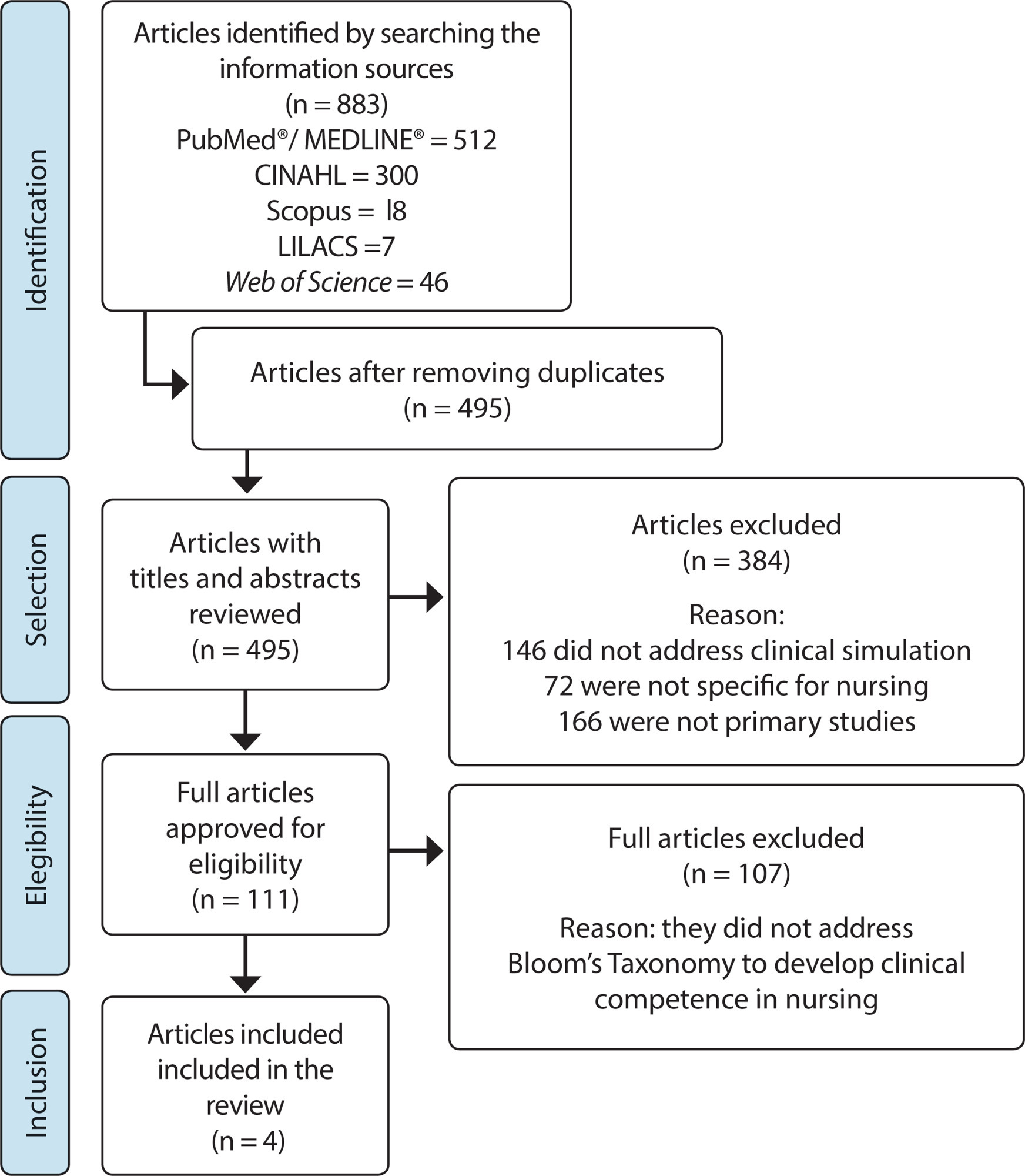
-
03-27-2020
Coronavirus 2020
Revista Brasileira de Enfermagem. 2020;73(2):e2020n2
Abstract
Coronavirus 2020
Revista Brasileira de Enfermagem. 2020;73(2):e2020n2
DOI 10.1590/0034-7167-2020730201
Views0Emerging and reemerging infectious diseases are constant challenges for public health worldwide. Recent cases of pneumonia of unknown cause in Wuhan, China, have led to the discovery of a new type of Coronavirus (2019-nCoV), which are enveloped RNA viruses, commonly found in humans, other mammals and birds, capable of causing respiratory, enteric, hepatic, and neurological […]See more -
ORIGINAL ARTICLE12-13-2019
Accessibility of children with special health needs to the health care network
Revista Brasileira de Enfermagem. 2019;72:65-71
Abstract
ORIGINAL ARTICLEAccessibility of children with special health needs to the health care network
Revista Brasileira de Enfermagem. 2019;72:65-71
DOI 10.1590/0034-7167-2017-0899
Views0See moreABSTRACT
Objective:
To know how children with special health needs access the health care network.
Method:
This is a qualitative research of descriptive-exploratory type, developed using semi-structured interviews mediated by the Talking Map design. Participants were 19 family caregivers of these children in two Brazilian municipalities. Data were submitted to inductive thematic analysis.
Results:
Difficulties were mentioned from the diagnosis moment to the specialized follow-up, something represented by the itinerary of the c hild and his/her family in the search for the definition of the medical diagnosis and the access to a specialized professional; a gap between the children’s needs and the care offered was observed in primary health care.
Conclusion:
The access of children with special health needs is filled with obstacles such as slowness in the process of defining the child’s diagnosis and referral to a specialist. Primary health care services were replaced by care in emergency care units.
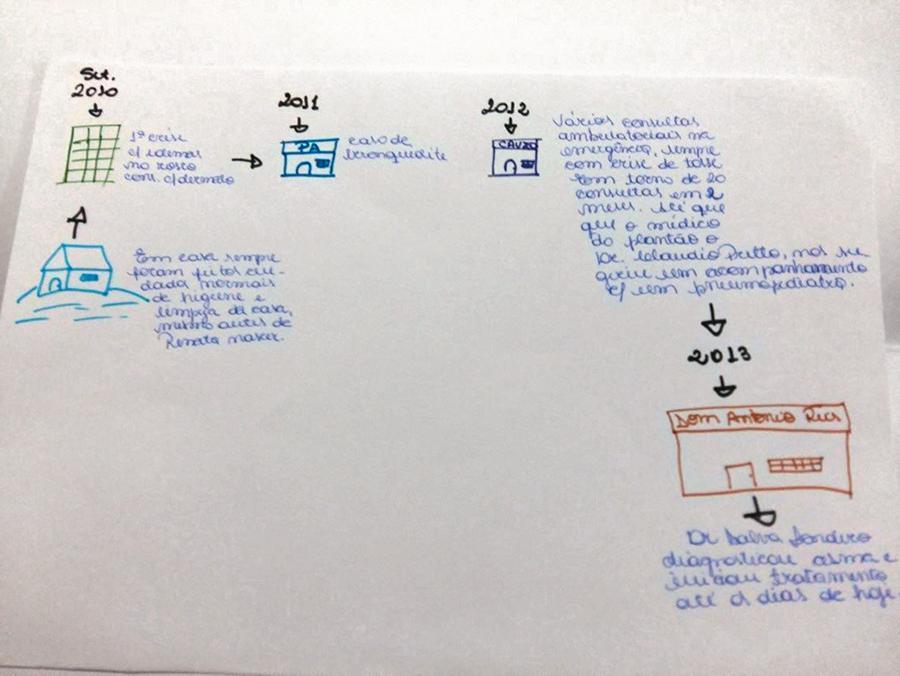
Search
Search in:
Nuvem de Tags
Adolescente (85) Atenção Primária à Saúde (239) COVID-19 (91) Criança (91) Cuidados de Enfermagem (269) Educação em Enfermagem (151) Educação em Saúde (139) Enfermagem (930) Enfermagem Pediátrica (86) Estudantes de Enfermagem (77) Estudos de Validação (131) Família (87) Idoso (208) Promoção da Saúde (99) Qualidade de Vida (104) Saúde do Trabalhador (86) Saúde Mental (145) Saúde Pública (82) Segurança do Paciente (150) Tecnologia Educacional (100)



